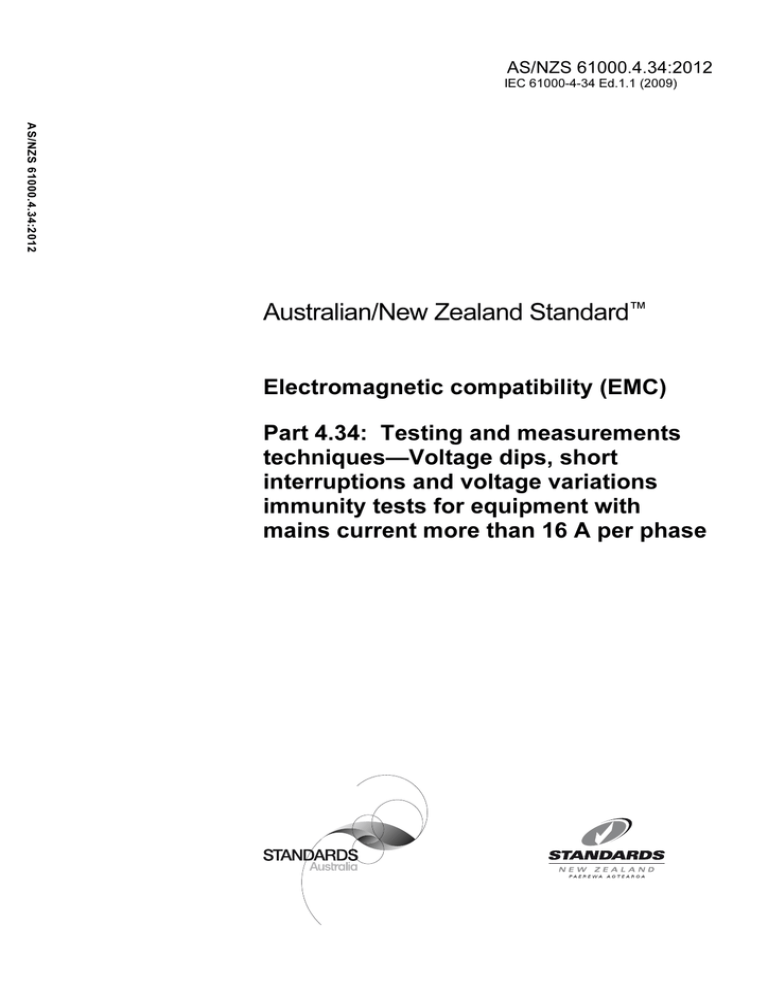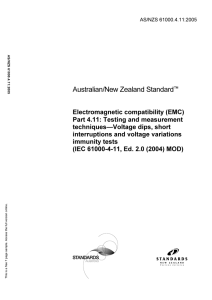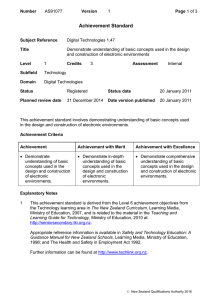
AS/NZS 61000.4.34:2012
IEC 61000-4-34 Ed.1.1 (2009)
AS/NZS 61000.4.34:2012
Australian/New Zealand Standard™
Electromagnetic compatibility (EMC)
Part 4.34: Testing and measurements
techniques—Voltage dips, short
interruptions and voltage variations
immunity tests for equipment with
mains current more than 16 A per phase
AS/NZS 61000.4.34:2012
This Joint Australian/New Zealand Standard was prepared by Joint Technical
Committee EL-034, Power Quality. It was approved on behalf of the Council of
Standards Australia on 4 June 2012 and on behalf of the Council of Standards New
Zealand on 7 June 2012.
This Standard was published on 28 June 2012.
The following are represented on Committee EL-034:
Australian Chamber of Commerce and Industry
Australian Industry Group
Australian Information Industry Association
Bureau of Steel Manufacturers of Australia
Consumer Electronics Suppliers Association
Consumers Federation of Australia
Electrical Regulatory Authorities Council
Electricity Engineers Association, New Zealand
Energy Networks Association
Engineers Australia
Lighting Council of Australia
Ministry of Economic Development, New Zealand
National Measurement Institute
New Zealand Coordinating Committee on Power & Telecommunication Systems
New Zealand Electric Fence Energiser Manufacturers Standards WG
Telstra Corporation
University of Canterbury, New Zealand
University of Wollongong
Keeping Standards up-to-date
Standards are living documents which reflect progress in science, technology and
systems. To maintain their currency, all Standards are periodically reviewed, and
new editions are published. Between editions, amendments may be issued.
Standards may also be withdrawn. It is important that readers assure themselves
they are using a current Standard, which should include any amendments which
may have been published since the Standard was purchased.
Detailed information about joint Australian/New Zealand Standards can be found by
visiting the Standards Web Shop at www.saiglobal.com.au or Standards New
Zealand web site at www.standards.co.nz and looking up the relevant Standard in
the on-line catalogue.
For more frequent listings or notification of revisions, amendments and
withdrawals, Standards Australia and Standards New Zealand offer a number of
update options. For information about these services, users should contact their
respective national Standards organization.
We also welcome suggestions for improvement in our Standards, and especially
encourage readers to notify us immediately of any apparent inaccuracies or
ambiguities. Please address your comments to the Chief Executive of either
Standards Australia or Standards New Zealand at the address shown on the back
cover.
This Standard was issued in draft form for comment as DR AS/NZS 61000.4.34.
AS/NZS 61000.4.34:2012
Australian/New Zealand Standard™
Electromagnetic compatibility (EMC)
Part 4.34: Testing and measurements
techniques—Voltage dips, short
interruptions and voltage variations
immunity tests for equipment with
mains current more than 16 A per phase
Originated as AS/NZS 61000.4.34:2007.
Second edition 2012.
COPYRIGHT
© Standards Australia Limited/Standards New Zealand
All rights are reserved. No part of this work may be reproduced or copied in any form or by
any means, electronic or mechanical, including photocopying, without the written
permission of the publisher, unless otherwise permitted under the Copyright Act 1968
(Australia) or the Copyright Act 1994 (New Zealand).
Jointly published by SAI Global Limited under licence from Standards Australia Limited,
GPO Box 476, Sydney, NSW 2001 and by Standards New Zealand, Private Bag 2439,
Wellington 6140
ISBN 978 1 74342 188 8
AS/NZS 61000.4.34:2012
2
PREFACE
This Standard was prepared by the Joint Standards Australia/Standards New Zealand Committee
EL-034, Power Quality to supersede AS/NZS 61000.4.34:2007.
The objective of this Standard is to establish a common reference for evaluating the immunity of
electric and electronic equipment when subjected to voltage dips, short interruptions and voltage
variations.
This Standard is an adoption with national modifications and has been reproduced from
IEC 61000-4-34 Ed.1.1 (2009), Electromagnetic compatibility (EMC)—Part 4-34: Testing and
measurement techniques—Voltage dips, short interruptions and voltage variations immunity tests for
equipment with mains current more than 16 A per phase, and has been varied as indicated to take
account of Australian/New Zealand conditions.
Variations to IEC 61000-4-34:2009 are indicated at the appropriate places within this Standard.
Strikethrough (example) identifies IEC text, tables and figures which, for the purpose of this
Australian Standard, are deleted. Where text, tables or figures are added, each is set in its proper place
and identified by shading (example).
IEC 61000-4-34 Ed.1.1 (2009) consists of the IEC 61000-4-34 Ed.1.0 (2005) and its amendment 1
(2009). A vertical line in the margin of the document shows where the base publication has been
modified by amendment 1.
As this Standard is reproduced from an International Standard, the following applies:
(a)
Its number appears on the cover and title page while the International Standard number appears
only on the cover.
(b)
In the source text ‘this part of IEC 61000’ should read ‘this part of AS/NZS 61000’.
(c)
A full point substitutes for a comma when referring to a decimal marker.
The terms ‘normative’ and ‘informative’ have been used in this Standard to define the application of
the annex to which they apply. A ‘normative’ annex is an integral part of a Standard, whereas an
‘informative’ annex is only for information and guidance.
AS/NZS 61000.4.34:2012
3
–2–
CONTENTS
CONTENTS
1
Scope ............................................................................................................................... 7
2
Normative references ....................................................................................................... 8
3
Terms and definitions ....................................................................................................... 8
4
General ............................................................................................................................ 9
5
Test levels ...................................................................................................................... 10
6
5.1 Voltage dips and short interruptions ...................................................................... 10
5.2 Voltage variations (optional) .................................................................................. 11
Test instrumentation ....................................................................................................... 14
7
6.1 Test generator ....................................................................................................... 14
6.2 Power source ........................................................................................................ 15
Test set-up ..................................................................................................................... 15
8
Test procedures ............................................................................................................. 15
9
8.1 Laboratory reference conditions ............................................................................ 16
8.2 Execution of the test .............................................................................................. 16
Evaluation of test results ................................................................................................ 19
10 Test report...................................................................................................................... 19
Annex A (normative) Test generator current drive capability ................................................ 20
Annex B (informative) Electromagnetic environment classes ................................................ 22
Annex C (informative) Vectors for three-phase testing ......................................................... 23
Annex D (informative) Test instrumentation ......................................................................... 29
Annex E (informative) Dip immunity tests for equipment with large mains current ................ 32
Bibliography .......................................................................................................................... 34
Figure 1 – Voltage dip – 70 % voltage dip sine wave graph ................................................... 13
Figure 2 – Voltage variation .................................................................................................. 13
Figure 3a – Phase-to-neutral testing on three-phase systems ............................................... 18
Figure 3b – Phase-to-phase testing on three-phase systems – Acceptable Method 1
phase shift ............................................................................................................................ 18
Figure 3c – Phase-to-phase testing on three-phase systems – Acceptable Method 2
phase shift ............................................................................................................................ 18
Figure 3d – Not acceptable – phase-to-phase testing without phase shift .............................. 18
Figure A.1 – Circuit for determining inrush current drive capability ........................................ 21
Figure C.1 – Phase-to-neutral dip vectors ............................................................................. 23
Figure C.2 – Acceptable Method 1 – phase-to-phase dip vectors .......................................... 25
Figure C.3 – Acceptable Method 2 – phase-to-phase dip vectors .......................................... 27
Figure D.1 – Schematic of example test instrumentation for voltage dips and short
interruptions using tapped transformer and switches ............................................................. 29
AS/NZS 61000.4.34:2012
4
–3–
Page
Figure D.2 – Applying the example test instrumentation of Figure D.1 to create
the Acceptable Method 1 vectors of Figures C.1, C.2, 4a and 4b .......................................... 30
Figure D.3 – Schematic of example test instrumentation for three-phase voltage dips,
short interruptions and voltage variations using power amplifier ............................................ 31
Table 1 – Preferred test level and durations for voltage dips ................................................. 11
Table 2 – Preferred test level and durations for short interruptions ....................................... 11
Table 3 – Timing of short-term supply voltage variations ....................................................... 11
Table 4 – Generator specifications ........................................................................................ 14
Table A.1 – Minimum peak inrush current capability.............................................................. 20
Table C.1 – Vector values for phase-to-neutral dips .............................................................. 24
Table C.2 – Acceptable Method 1 – vector values for phase-to-phase dips ........................... 26
Table C.3 – Acceptable Method 2 – vector values for phase-to-phase dips ........................... 28
AS/NZS 61000.4.34:2012
5
FOREWORD
A vertical line in the margin shows where the base publication has been modified by
amendment 1.
AS/NZS 61000.4.34:2012
6
NOTES
–7–
AS/NZS 61000.4.34:2012
7
AUSTRALIAN/NEW ZEALAND STANDARD
Electromagnetic Compatibility (EMC)
Electromagnetic compatibility (EMC)
Part 4.34:
Testing and measurements techniques—Voltage dips, short interruptions
and voltage variations immunity tests for equipment with mains current
more than 16 A per phase
Any table, figure or text of the international standard that is struck through is not part of this
standard. Any Australian/New Zealand table, figure or text that is added is part of this
standard and is identified by shading.
1
Scope
This part of IEC 61000 defines the immunity test methods and range of preferred test levels
for electrical and electronic equipment connected to low-voltage power supply networks for
voltage dips, short interruptions, and voltage variations.
This standard applies to electrical and electronic equipment having a rated mains current
exceeding 16 A per phase. (See Annex E for guidance on electrical and electronic equipment
rated at more than 200 A per phase.) It covers equipment installed in residential areas as well
as industrial machinery, specifically voltage dips and short interruptions for equipment
connected to either 50 Hz or 60 Hz a.c. networks, including 1-phase and 3-phase mains.
NOTE 1
Equipment with a rated mains current of 16 A or less per phase is covered by publication IEC 61000-4-11.
NOTE 2 There is no upper limit on rated mains current in this publication. However, in some countries, the rated
mains current may be limited to some upper value, for example 75 A or 250 A, because of mandatory safety
standards.
It does not apply to electrical and electronic equipment for connection to 400 Hz a.c.
networks. Tests for equipment connected to these networks will be covered by future IEC
standards.
The object of this standard is to establish a common reference for evaluating the immunity of
electrical and electronic equipment when subjected to voltage dips, short interruptions and
voltage variations.
NOTE 1
Voltage fluctuations are covered by publication IEC 61000-4-14.
NOTE 2 For equipment under test with rated currents above 250 A, suitable test equipment may be difficult to
obtain. In these cases, the applicability of this standard should be carefully evaluated by committees responsible
for generic, product and product-family standards. Alternatively, this standard might be used as a framework for an
agreement on performance criteria between the manufacturer and the purchaser.
The test method documented in this part of IEC 61000 describes a consistent method to
assess the immunity of equipment or a system against a defined phenomenon. As described
in IEC Guide 107, this is a basic EMC publication for use by product committees of the IEC.
As also stated in Guide 107, the IEC product committees are responsible for determining
whether this immunity test standard should be applied or not, and if applied, they are
responsible for defining the appropriate test levels. Technical committee 77 and its subcommittees are prepared to co-operate with product committees in the evaluation of the value
of particular immunity tests for their products.
COPYRIGHT
AS/NZS 61000.4.34:2012
Electromagnetic compatibility (EMC) - Part 4.34: Testing and
measurements techniques - Voltage dips, short interruptions and
voltage variations immunity tests for equipment with mains current
more than 16 A per phase
This is a free sample only.
Purchase the full publication here:
http://shop.standards.co.nz/catalog/61000.4.34%3A2012%28AS%7CNZS%29/view
Or contact Standards New Zealand using one of the following methods.
Freephone:
Phone:
Fax:
Email
0800 782 632 (New Zealand)
+64 4 498 5990
+64 4 498 5994
enquiries@standards.co.nz





